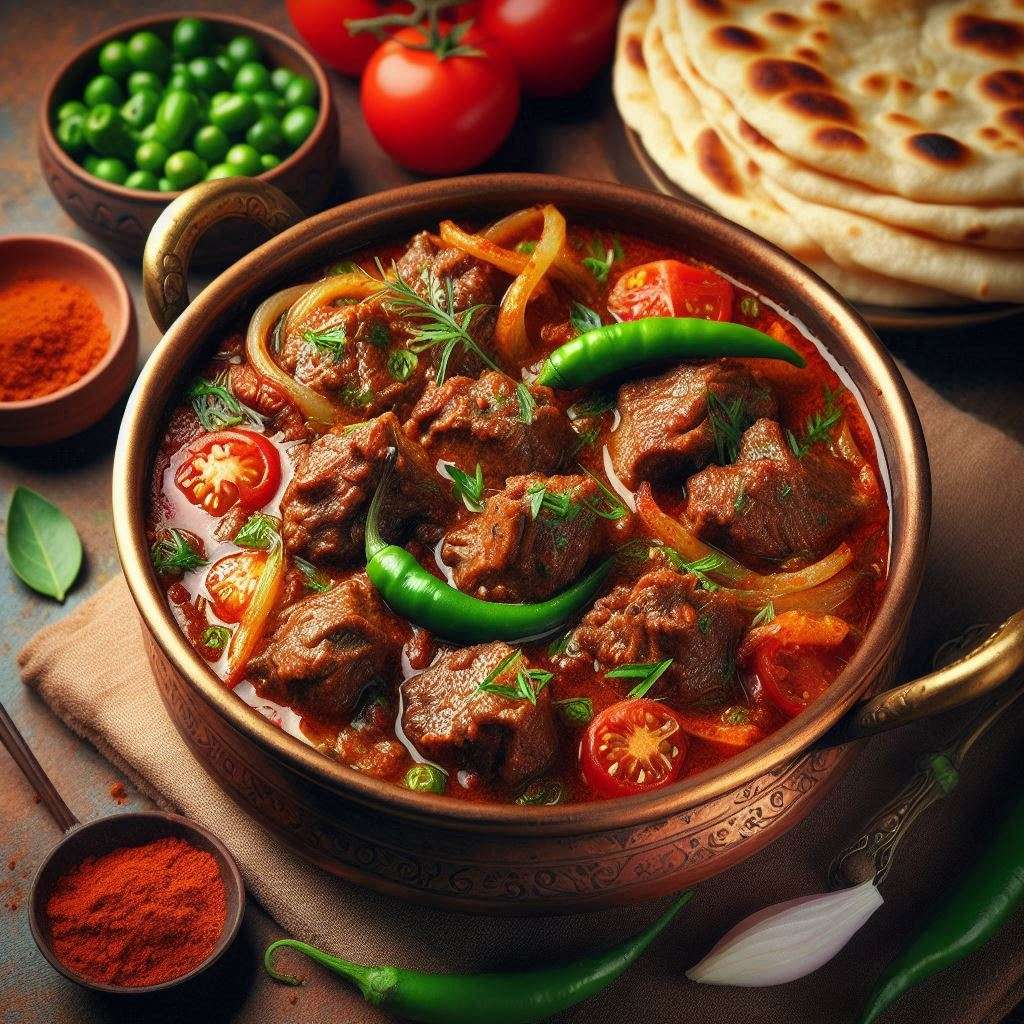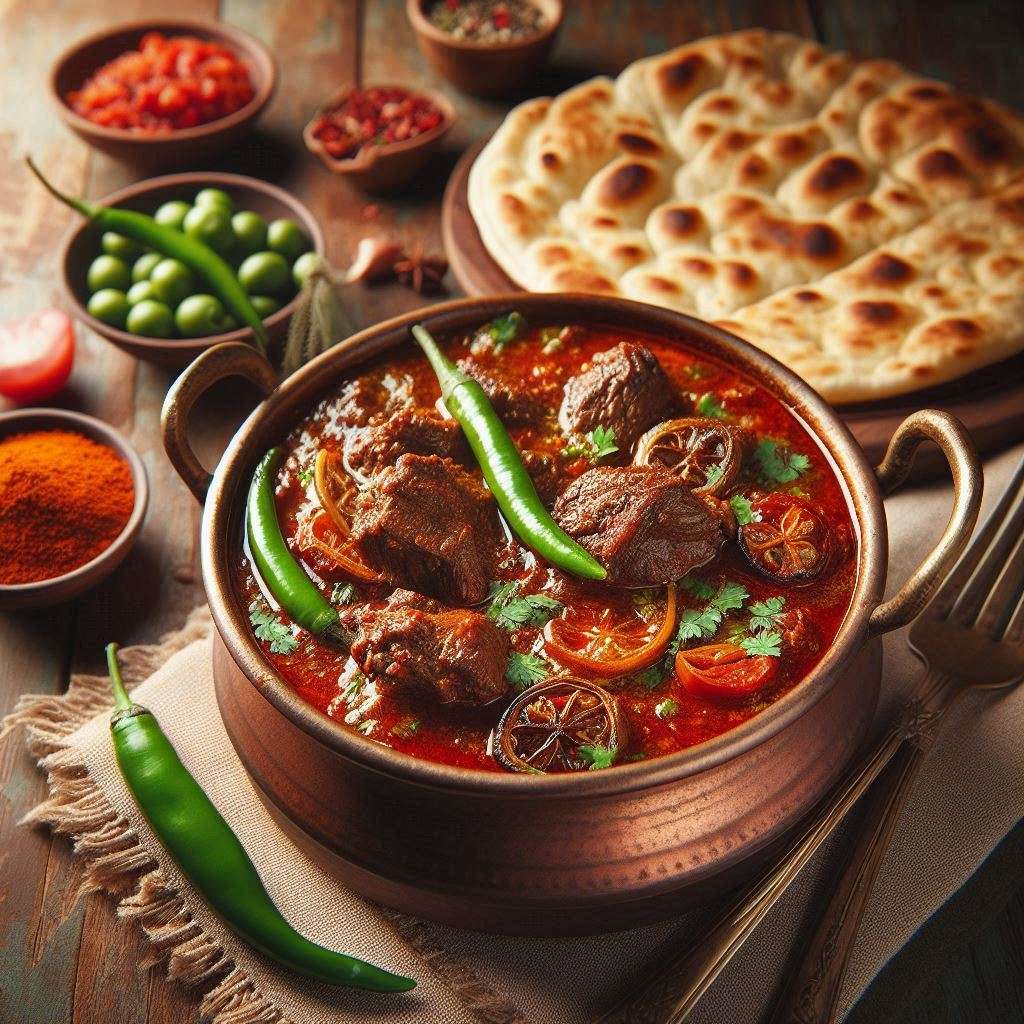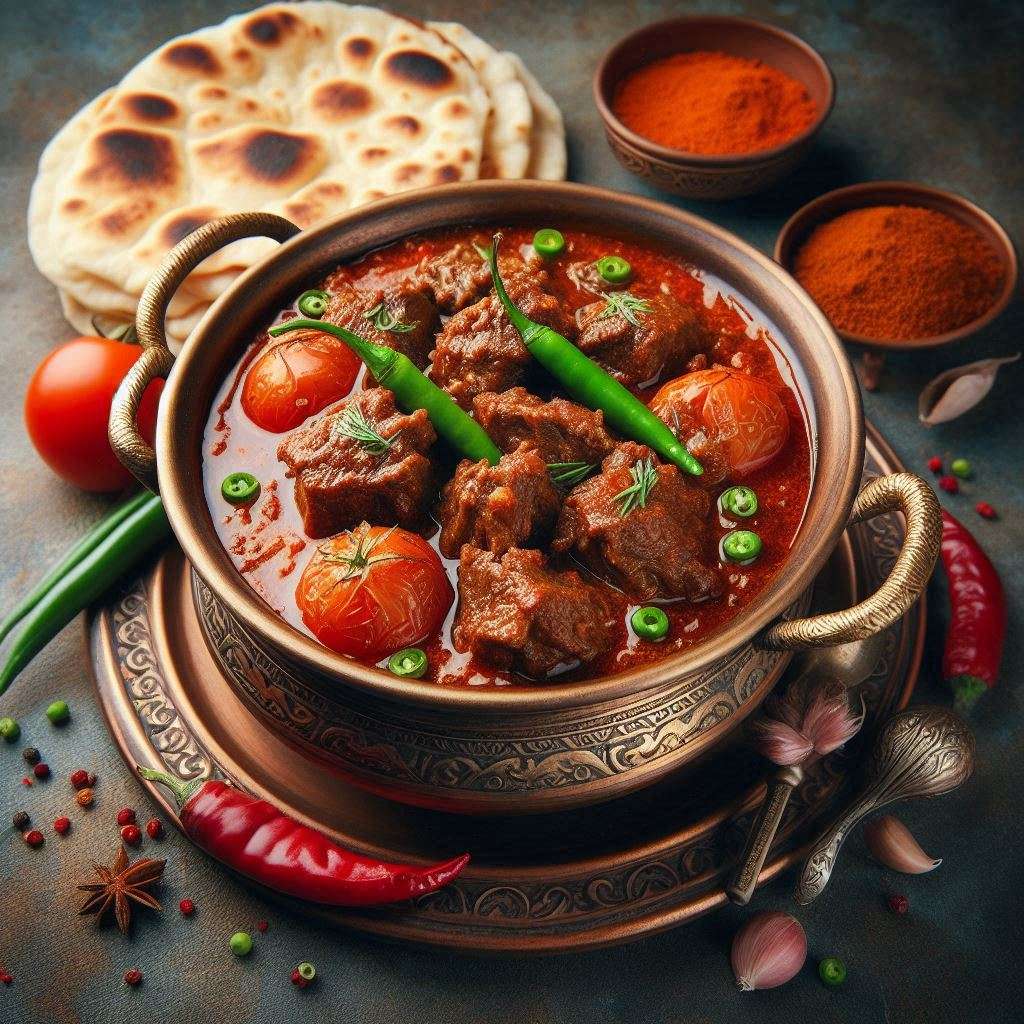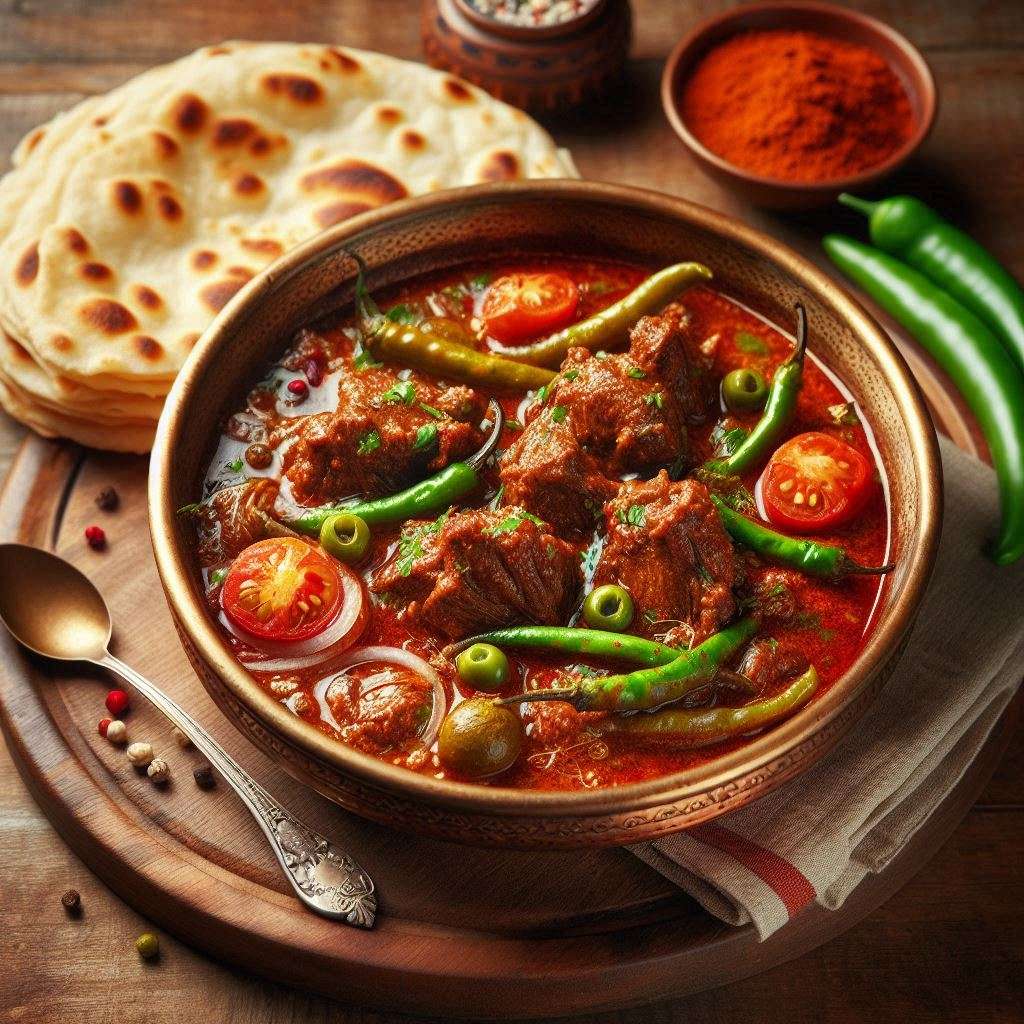Mutton Karahi | Karahi Mutton Gosht Recipe
Mutton Karahi | Karahi The Mutton Gosht Recipe is an beautiful, delicious, and flavoursome old-fashioned Pakistani non-vegetarian recipe that has earned the fame and appreciation of food lovers across the globe. This fragrant and rather dense curry proves that South Asian cuisine is characterized by the use of rather powerful spices and varied techniques. So, in this article that you are reading, we’ll share an understanding of Mutton Karahi, starting from the background of the dish and understanding the parts used for Mutton, what other ingredients are incorporated, the process of preparing Mutton Karahi, and the importance that makes Mutton Karahi a famous food consumed in Pakistani homes and restaurants.

The origins of Mutton Karahi.
Mutton Karahi | Karahi Mutton Gosht will be very familiar to those with origins in the northern areas of Pakistan and India.Originally prepared in the Punjab region, Mutton Karahi has gained much demand in Pakistan and India and in international restaurants. Its strong aroma and juicy texture give it a specific taste of South Asia, making it a favorite of many people.
Stir-fry lamb with fresh tomatoes
Mutton Karahi is a dish where the harmony of spices and the cut of meat is such a wonderful process that it can be best described as a science and an art. It is all about proportions, using qualitative meats, and long and slow cooking, which reveals the depth of spices used. It is time to look at the components that give this dish its unique taste; it will be easier to recreate.
Ingredients for Mutton Karahi
To prepare a delicious mutton karahi, you’ll need the following ingredients:
- One kilogram of Mutton, preferably with bones, especially for the pieces with bones.
- 4-5 medium-sized fresh tomatoes, chopped.
- One big onion stated
- 4-5 green chillies, cut longitudinally
- Two tablespoons of ginger-garlic paste
- 1/2 cup cooking oil or ghee
- Two teaspoons of cumin seeds
- Coriander powder: 2 teaspoons
- One teaspoon of red chilli powder, or according to your preference
- Source: Based on the original ingredient list from the Ned Steam Packet Cookery & Fisheries Book, some substitution measurements have been changed: ½ teaspoon turmeric powder.
- Salt to taste
- Coriander leaves for garnishing the dish should be fresh.
- Julienne ginger for garnishing a dish
- 1/2 cup yoghurt you can add if you want to, but I don’t usually do it while I’m cooking.
The Recipe: How to Make the Best Mutton Karahi
With our ingredients prepared, it is time to proceed with preparing this yummy food delicacy.
Preparing the meat
The first step in making a good mutton karahi is choosing and preparing the proteins, in this case, Mutton. Select good mutton cuts; it is better to keep the mutton pieces whole with bones to enhance the flavour. Rinse the meat in running water and allow the water to drain off the meat. Some cooks prefer to put the Mutton in yoghurt and spices and let it sit for a few hours before preparing it, but it is not compulsory.
Heating the Karahi
Please turn the heat to medium and place your karahi or deep, heavy-bottomed pan on it. The oil or ghee will go in, and the dish will warm up. It would help if you were very careful at this stage. The preference for a traditional karahi in cooking the dish alongside the paprika also contributes to the dish’s superior flavour. However, a conventional pan may be used if the former is unavailable.
Sautéing the Aromatics
After the oil has heated for a few moments, add the cumin seeds and pop them in the oil for a few seconds. Next, add the fine slices of onions and stir until they are well browned. This process is known to the trade as browning the onions; it is an important step in building up the background flavour of the Mutton Karahi.
Adding the spices
Following it, blend in the ginger-garlic paste to the browned onions and fry the mixture for another minute until the paste no longer emits a raw smell. Next, sprinkle and mix the powdered spices: coriander, red chilli, and turmeric. Stir the ingredients together well, and let the spices Fry for 1 or 2 minutes to heat them up.
Cooking the Mutton
Now, it’s time to cook the main ingredient of Mutton Karahi, which goes to every single good Mutton Karahi recipe worldwide: the mutton meat itself. Pour the mutton pieces into the karahi and mix with the spice mixture to cover all the pieces. Spice up the meat to medium-high and fry it for roughly 10–15 minutes; use a spoon to turn it frequently until it attains a slightly brown hue.

Adding the tomatoes
After the meat is brown, chopped tomatoes are poured into the karahi. Stir it with a spoon and let the tomatoes soften, start to break down, and ooze out their juices. This step is important in building the thickness of the gravy, which is typically flavorful and slightly sour, which is a requirement of a good Mutton Karahi.
Even at a low temperature, slow cooking provides meat with just the right tenderness; it needs to be perfect.
What follows is the most crucial step in preparing mutton karahi. Lower the heat now and let the mutton cook on slow flames with the help of the karahi lid. In this way, the meat is subjected to slow cooking that renders it tender and fully immersed in the spiced, tomatoey sauce.
Final Touches
When the meat is cooked and the gravy has become thick per your provisions, it is time to garnish your mutton karahi. Submerge the slit green chillies in it and mix them around. If you use yoghurt, it is the right time to incorporate it into the dish. The yoghurt gives the stew a smooth texture and aids in cooling the effect of the spices.
Garnishing and Serving
Lastly, sprinkle Kasuri Methi, green coriander leaves, and a few strips of ginger on your mutton karahi. This gives the dish a splash of colour and improves its fragrance and taste.
Ultimately, taste your mutton karahi and serve it hot, preferably still in the karahi, for that traditional look. Naan, roti, or simply steamed rice complement it very well and take the taste and juiciness to the next level.
On the Cultural Significance of Mutton Karahi
Mutton Karahi is important to Pakistan’s food heritage. It forms a central part of almost all family and festive occasions, functions, and events. The concept of eating Mutton karahi cooked in the karahi, where everyone sits around it and uses pieces of naan to scoop up the meagre gravy, also reflects the culture of Pakistan’s warm hospitality.
In most provinces of Pakistan, particularly the northern area, mutton karahi is not only considered a meal but rather an event. Similarly, prepared restaurants that serve Karahi Mutton Gosht will probably have fully operational kitchens that offer the view of the cooking mastery that this mouthpiece calls for from accomplished chefs.
Variations of Mutton Karahi
Besides a fundamental recipe for Mutton Karahi, slight differences originating from regions also contribute to its preparation. It is sometimes garnished with garam masala or black pepper, or it even contains nuts or dried fruits for texture.
Some restaurants in Pakistan may offer a dry form of Mutton Karahi, where the dish’s gravy is a thick paste sticking to the Mutton. This style is preferred by those who like to taste coffee in its concentrated form.
The following are the health benefits associated with having mutton karahi:
In moderation, though, Karahi, as succulent as it is, can be useful for a health boost, especially for those who need good-quality protein. Mutton contains a high degree of proteins and vitamins and is high in minerals, making it a quality product. Some of the spices used in the preparation of the dish, including turmeric and cumin, are considered to have anti-inflammatory and easing effects on digestion systems.
However, it must be noted that Mutton Karahi’s authentic recipes contain large quantities of fat provided by ghee or oil.
SOME USEFUL TIPS THAT WILL HELP YOU GET THE PERFECTION INKARAHI
To ensure your Karahi turns out perfect every time, keep these tips in mind:
- This means that they should use fresh products for cooking, especially good-quality meat and spices.
- Take your time when you are cooking, because taking time is the key to the best food. Slow cooking is the reason why Mutton Karahi has a rich taste and melt-in-the-mouth tender pieces of meat.
- You can alter the spiciness according to your taste buds. The good thing about preparing this Mutton Karahi at home is that you can adjust it to your preference.
- It is best to use a traditional karahi in cooking; if unavailable, a heavy-bottomed pan can be used. The characteristic shape of the karahi and the construction of the pan affect the overall flavour and taste of the food.
- Allow the mutton karahi to sit and stand for 5–10 minutes before serving. This allows the flavours to penetrate well and the gravy somewhat firm.
Conclusion
Mutton Karahi is a traditional Pakistani and Indian recipe that is more than just a dish; it honours the customs and passion of the people who prepare it. When prepared at home or eaten out, it summarizes the experience of Pakistani food in one dish.

FAQs
What are the nutritional benefits of mutton karahi?
Mutton Karahi consumed in a reasonable amount is not a threat to one’s diet, as many benefits come with it. It has protein and good spices, but the fats depend on the preparation process of the food item.
Is there a way to freeze mutton karahi?
It is possible to freeze Mutton Karahi, and it will remain fresh for up to 3 months. To enjoy it at its best, it must be thawed in the refrigerator and gently warmed.
